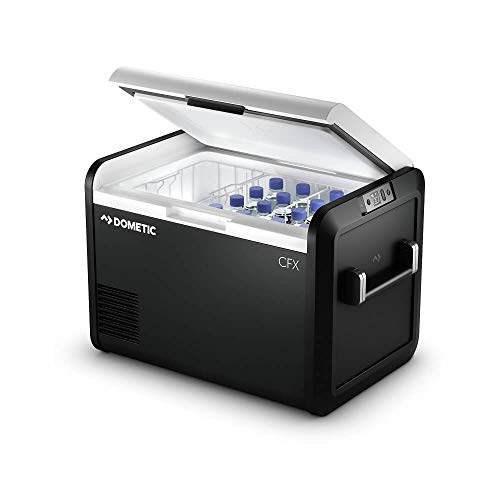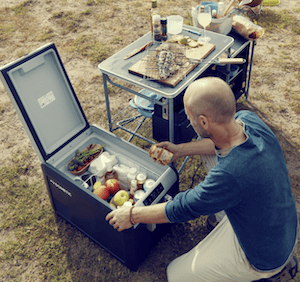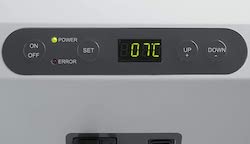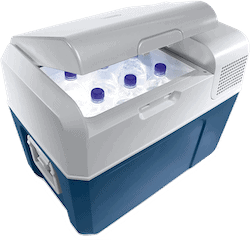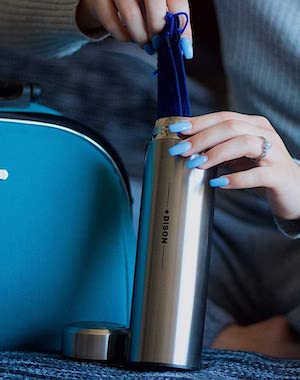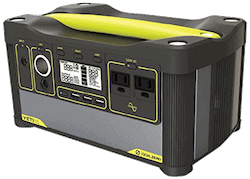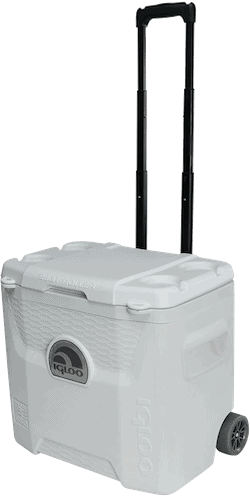If you’ve already read our buyers’ guide to camping fridges and coolboxes, you should have a good idea of what kind of coolbox is best for particular scenarios.
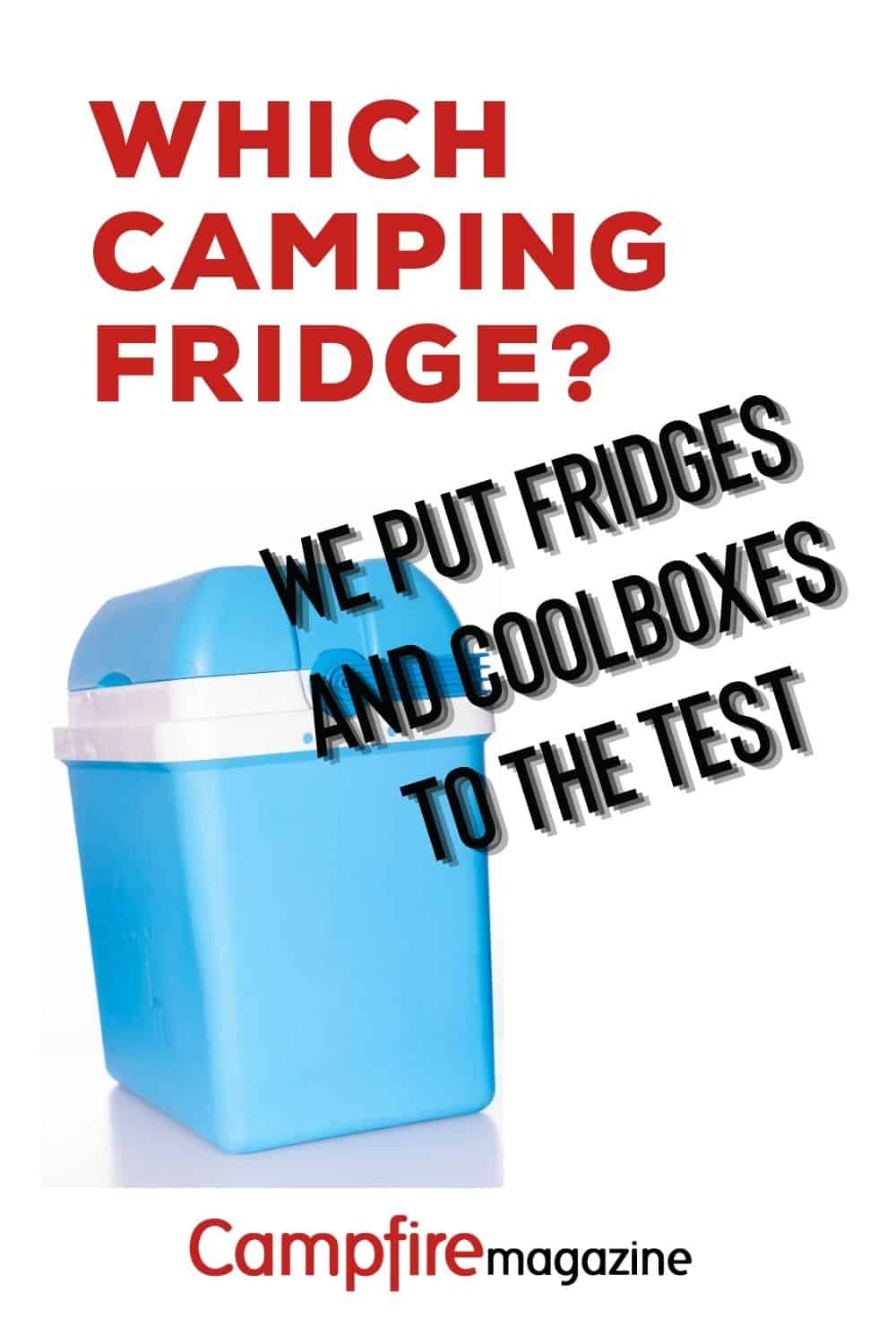
Now it’s time to look at some actual models to see how well they perform.
All our reviews at Campfire Magazine are independent and honest.
In a hurry? If you don’t have much time using the links below to quickly find our favourite coolboxes and fridges for you on Amazon. You can be assured we only choose the best products…
What are the different types of camping fridges and coolers?
Passive coolboxes and bags
- Passive coolboxes or coolers are insulated boxes or bags that you keep cool with ice-blocks or frozen drinks bottles. Their advantages are that you don’t need power and they’re usually cheaper and lighter.
- The disadvantage? You’ll need to constantly refreeze your blocks if you’re camping for more than a couple of days.
Electric or thermoelectric coolboxes
- These are insulated boxes with the addition of an electric fan. They can be powered in your car or, usually with an adaptor, on the mains hook-up at a campsite.
- How cold they stay inside depends on how hot it is outside. They won’t keep food as cool as a home fridge (which is around 5°C) if your outside temperature is in the 20°Cs or 30°Cs.
Compressor coolboxes and camping fridges
- Compressor fridges are the top of the range because you can set a temperature for your food, or even freeze it, and that’s what you’ll get – unaffected by the searing sun outside. They’ll have to do more work in hotter temperatures, of course, which means they’ll run more often but they’re very efficient.
- They run on the car battery and also on mains (some will only freeze when on mains power). Many have power-savings features and some can operate with solar.
Absorption coolers or three-way fridges
- Absorption fridges start at around 30-litres in size and are the big boys of the coolbox world. They’re sometimes called three-way fridges.
- They run on 12/230v electricity and also gas. They make no noise and can cool up to 33°C below ambient.
If you haven’t read our full fridge guide, you might want to do that first – it’ll help you narrow down your choice so you buy (and spend) only what you really need.
Buying tips
Where we’ve given sizes for camping fridges, do check measurements before buying. Manufacturers aren’t consistent in what they call ‘depth’ – sometimes it means length!
There are a lot of older models around, which might be fine for you. But, if you want the latest, do check the model numbers.
All Dometic’s new models will say Dometic rather than Waeco on them.
We do have a bit of a preference for Dometic (was Waeco). They’ve have grabbed the market for higher-end options and it’s their ranges you’re most likely to come across. They’re reliably good.
You can also find slightly cheaper camping fridges branded IceCube, Berg and Bluefin, among others.
Now read on with our reviews.
DOMETIC
OUR TOP PICK
We tested the CDF36. Despite its name, this is actually a 31-litre fridge/freezer that’s high enough to take upright wine bottles and two-litre bottles.
There’s a cold section and a smaller area equivalent to the salad drawer in your home fridge, and even an interior LED light. A pull-out basket makes it easy to transfer things from the fridge to the cooler when you’re packing. Its temperature range is +10 to -15, and, being a compressor, it’ll achieve those temperatures whatever the heat outside.
It works on the 12V car or leisure battery and can be used on mains too. The CDF range goes from 10.5 litres to 39 litres. For bigger, you need to look at the CFX range.
What we liked
- Very quiet indeed, and the compressor switches off when it’s at temperature, so you also get complete silence (unlike the continual fan noise of a thermoelectric).
- The slim shape makes it easy to fit behind the front seats or in the boot (remember that you need to allow a bit of space for ventilation around it). And the flat top is useful.
- It uses very little power (DC@5/25°C – 0.59 kWh/24h).
- A battery-saving cut-off makes sure you always have enough car battery left to start the vehicle.
- It was very cold within 15 minutes.
What could be better
- Some of Dometic’s fridges have carrying handles, but the CDFs have integrated grab-handles, which some people may struggle with.
You might also come across the odd CF26 model. Personally, given that these are no cheaper, we can’t see there value. Opt for CDF or CFX instead.
BEST FRIDGE
Could this be the ultimate camping fridge? The CFX3 is Dometic’s latest compressor fridge and, although you won’t be able too inexpensive, they certainly offer a lot of features.
There are seven models – from 32-litres to 88-litres – and you can choose a model that will either chill or freeze, models with an ice maker compartment or true dual-zone fridge/freezers.
A gimmick? We’re not sure yet, but some will love the idea of being able to control temperature and battery level using a smartphone app.
They look great and are made to be durable but lightweight. The frame has protection round the edges and there are tough aluminium alloy handles.
The VMS03 compressor is the best yet, with powerful and efficient cooling and freezing down to -22C. A good compressor is one thing, but you also need excellent insulation and sealing to make a fridge really efficient, and the CX3 has all of these.
Many models go regularly out of stock. It definitely pays to check on Ebay as well. There’s usually a good range that come direct from Europe with free or reasonable delivery. Plenty of guarantees against bad sellers too!
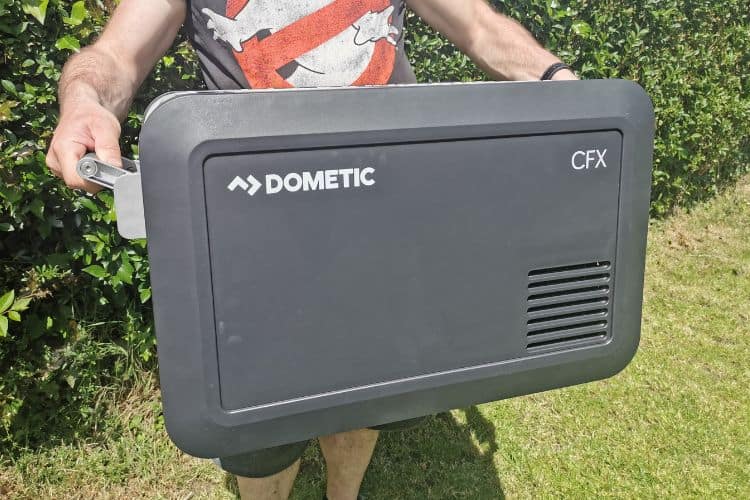
CFX3 35 – Portable compressor cool box and freezer, 32 l
CFX3 45 – Portable compressor cool box and freezer, 40 l
CFX3 55 – Portable compressor cool box and freezer, 48 l
CFX3 55IM – Portable compressor cool box and freezer with ice maker function, 48l.
CFX3 75DZ – Mobile dual-zone compressor cool box and freezer, 65 l
CFX3 95DZ – Mobile dual-zone compressor cool box and freezer, 82 l
Cooling power
All the new CFX3 fridges can run on AC, DC and solar. The low power consumption using DC makes them perfect for pairing with solar panels.
Have a look at our power for campers article for some ideas here, especially how Gary Charman has set up his CFX3 75DZ to run on solar power.
What we liked
- The most efficient compressor fridge you can buy (can freeze too).
- Separate ice or freezing compartments on the larger models.
- Reinforced corners and solid carrying handles.
- Works on mains or 12v.
- Digital temperature display – and even an app to control temperatures!
- There’s also a USB charging socket on the rear.
Cons
- Basket can be a bit ‘tricky to remove when full unless you’re standing right over it.
- It’s quite deep, so there will be some organising to do to avoid having to take everything out to find the butter!
- Not cheap, but a solid investment.
Dometic Hybrid – part compressor, part thermoelectric. An unusual one, this. The B40 (also called the CoolFun CK 40D!) is a 38-litre box-shaped portable fridge that operates on 12V as thermoelectric and on mains power using a compressor.
The idea is that you have a chill function on the 12V, but can use it as a freezer down to -15C on the compressor setting. You can’t do both at the same time, so you do need to work out how you’ll actually use it in practice. It is a cheap way of having a compressor fridge, however, check out the prices here.
Prices, we’ve found, vary wildly on this one. At the time of writing, they were far cheaper than Amazon, even with delivery costs included.
The shape is a good one for easy stowing, but it does weigh 22kg. It’s a good ‘un for the money.
Dometic absorption coolers
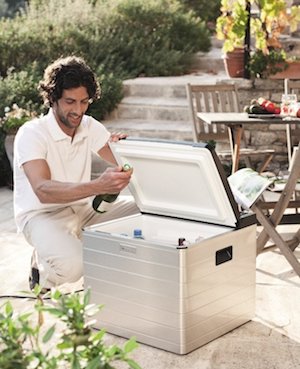
Lots of people like the versatility of an absorption cooler. They’ll run on gas or on either 12v or 230v electricity.
They do tend to be quite large and boxy, but the Dometic ones have a nice aluminium housing. These are the models we tested and rated highly.
What we liked
- Cools to 30C below ambient
- Box-shape with a flat lid makes it useful for putting things on.
- Silent running (love that film!).
- 12 volts in the vehicle, 230 volts at home or campsite and switch to gas for outdoor use.
- Fairly light at 14kg
Cons
- Takes up a lot of room.
- A bit unwieldy to carry.
Steer clear of the absorption coolers made by Royal and Tristar. We found them unreliable and not very robust, but still around the same price as the Dometic.
Compressor Fridges
OUR TOP COMPRESSOR FRIDGE
The Mobicool MCF range is brilliant. Set the temperature anywhere between -10 and +10C and the good insulation will keep power draw low. There’s a battery monitor on the control screen just in case.
Runs on 12V and 240V and very highly thought of amongst our readers. Three sizes – 31, 38 and 58 litres.
A new brand to us, but price is amazing and the 35l is about right for a couple or small family.
12V or 240V with cables supplied. There are also 30-litre, 40-litre and 50-litre versions.
We wondered how they managed to keep the price so low and I think I know the answer – it’s the insulation. The test is to see how long they stay cold when turned off and unopened. For these, they warmed way faster than the Dometics.
That’s not a problem if you’re keeping it turned on, but if you’re running on a leisure battery or solar, the extra power needed to keep it at temperature may be an issue for you.
Alpicool portable compressor fridges are one of the less well-known makes of compressor fridge.
The Alpicool compressor fridges are certainly a bit clunky-looking compared to the Dometic, but they’re also a bit cheaper. They both cool and can freeze..
There’s a 30-litre, 50-litre and 52-litre option.
They come with a 12V plug and an AC mains plug.
Possibly the ugliest camping fridges we’ve seen and definitely not the best insulated, but you may be won over by a starting price of for the 15l version and a 40l model.
There’s a dizzying array of sizes, including 18l, 20l and 25l. We haven’t tested these, but we have heard mixed thoughts from readers. If you want to try one, make sure you can return it easily.
Keeping medicines cool
For keeping insulin or medicines cool, you need a constant temperature, so it has to be a compressor fridge, but…
…although it makes sense to have a fridge you can also use for other things, you might not want to stretch to the cost of a compressor or prefer to have a separate portable medicine fridge.
There are some decent passive coolers designed for insulin, but the best option we’ve found is the LifeInABox portable medicine fridge.
It can hold eight insulin pens or bottles of injectables, has an app for control and runs from a normal power outlet or the 12V in your car or van. Constant temperature and a beautiful object too
Indel B/Webasto Travel Boxes
Indel B were the only competitors to Dometic. We say ‘were’, because they used to be cheaper than Dometic for around the same spec. They’re now barely more affordable and readers don’t rate them as highly.
One reason to choose them would be if you needed a very small fridge for between seats, for example.
We tried the TB18 model. This is DC-only (so uses the car socket). The TB18 is very compact and boasts a new BD micro compressor with integrated control electronics, which regulates the speed according to the temperature set, so consumption is reduced to a minimum.
We found it to be properly portable – very light and with an included carrying strap. Slightly noisier at first (that wears off) than the Dometic. Given that it’s price and small, it’s hard to wholeheartedly recommend it. But if you have the exact tiny space for it, maybe.
Reliable electric coolboxes
There are a lot of electric coolboxes, and some of them very cheap indeed. You need to check the insulation and, if you can, check the fan noise. These are the best we’ve found…
The Tropicool TCX range differs from the usual electric coolboxes in that the fan is at the bottom rather than in the lid.
They also have some clever power-saving electronics to improve performance and offer 12/24V and mains operation. There’s a display panel to set the desired temperature level. And they refrigerate down to -7°C below ambient temperature and heat up to +65°C.
We tested the TCX 21 model.
What we liked
- Lightweight.
- There’s just enough room and a removable partition for flexibility.
- The control panel was easy to use.
- It got cold quickly, though we weren’t operating it in Mediterranean conditions.
Cons
- We didn’t like the constant fan noise and wouldn’t want it next to us in a tent (or in a neighbour’s tent!). Unfortunately, that’s what you get with any thermoelectric box.
You get a lot of space for the money with the Mobicool 40l MQ40W. You can even stand 2l bottles upright inside.
It has two fans for faster chilling, and wheels and good handles make it easier to transport when it’s full of goodies. Plus, dual voltage and a split lid to help keep the cold in.
The 31l is here. There’s also a 20l and a good range of other sizes at decent prices.
Our advice for any coolbox (especially passive) is to check the insulation, because that’s what counts.
If you’re wondering about off-hook-up power for your fridge, read our guide to power for camping and campervans.
Pro grade passive coolboxes
There are hundreds of non-electric coolboxes out there that simply work by filling with ice or ice-packs. The level of insulation is what matters here.
There’s something very appealing about the simplicity of a passive coolbox. No need for electricity or adaptors, but you do need to top up the ice or refreeze the blocks, and it’ll never keep things as reliably cold as a compressor.
Don’t forget good iceblocks – the best we’ve found for maximising space and coldness are the Thermos Freezeboards.
BEST NON-ELECTRIC COOLBOX
These sturdy workhorses are the best when it comes to top-end, higher-priced passive coolers. Five days of ice at 30C? Not bad at all.
The Marine range (in white) is reliable. Sizes from 26l to enormous, stain and taint resistant interiors, superior insulation and prices is inexpensive.
Yes, please. This Igloo BMX cooler is fantastic, holds 49 litres and is both rugged and smart. The best insulation we’ve found.
We were interested to see how Dometic’s Cool-Ice passive coolboxes would measure up to our old Yeti (no longer available in the UK).
We tested a 22l model (other sizes available) and found it reassuringly sturdy.
Dometic’s tests have shown that if you filled one with ice, only opened it for a minute a day and removed the melted water, you’d still have enough ice left to make it effective after 10 days. This was on a constant 30-degree temperature. That looks impressive, but it’s not how people actually used their coolboxes, of course.
We froze a two-litre bottle of water, left it in the box in a sunny porch and checked on it three times a day. We got three days of useable coolness.
- We liked the Cool-Ice for being lighter and for its more useful shape – a flat-topped box that you can use as a side-table or stool.
- It has good hinges and latches, low heat absorption and is supremely sturdy. ‘Labyrinth’ seals ensure no cold can escape. There are spares available too.
- We especially like the new khaki coolboxes, available as 22-litre or 42-litre.
Lots of Campfire Mag readers have told us they love their Coleman passive coolboxes.
They have great insulation both in the walls and in the lid and can keep things cool for days (providing you fill the box and don’t open it too much).
The standard coolboxes come in five sizes – from 33 litres to 91. We tested the 47l wheeled version by completely filling it with ice packs and bottles of frozen water. We found we still had ice inside after four days. Not bad at all.
Unlike compressor fridges, however, performance will vary if it’s super-hot outside. Keep your coolbox out of the sun, if you can.
There’s also a nice 31-litre model with a single carrying handle.
We liked:
- The flat top and sturdy construction mean you can use them to sit on. There are cup-holders on the lid too.
- Fairly lightweight – until you fill them, of course.
- Excellent cooling.
- BPA-free plastic.
We weren’t so keen on the handles as they were a bit sharp to hold and carrying the bigger sizes feels a bit awkward.
Coolbag that actually works (even without icepacks)
This cheap coolbag from Decathlon is brilliant for picnics and weekends away.
With ice packs, you should get two or three days of cool temperature inside. Without ice, it’ll last all day (providing the food and drinks you put inside are cool already).
This one is the family-size 36-litre, but there’s a 26-litre version and two smaller backpack coolbags too.
Mini fridges for camping?
We’ve been asked quite a few times whether a tabletop mini fridge would work for camping. The short answer is “yes, but…”
These will generally work only on a standard wall socket (240V). The main problem, though, is noise. They do tend to make a bit of a racket. That’s partly because the motor needs to run for longer and more often than a well-insulated, made-for-camping compressor fridge.
Some people are happy to put up with this because they like the idea of having an extra little fridge at home.
The SubCold comes in 50l or 70l capacities and is a decent option .
Our top choices?
If budget isn’t an issue, we’d definitely opt for a compressor fridge from Dometic’s CFX3 range.
For a smaller budget, the CDF compressor fridges are fantastic value.
For a passive coolbox, it would be either the 22l khaki Dometic or the Igloo BMX.
And we’d always choose passive over a traditional thermoelectric because of the fan noise. But if you want an electric coolbox, go for the excellent Mobicool compressor.
Camping Fridge Buyers Guide
Passive coolboxes and bags
- Passive coolboxes or coolers are insulated boxes or bags that you keep cool with ice-blocks or frozen drinks bottles. Their advantages are that you don’t need power and they’re usually cheaper and lighter.
- The disadvantage? You’ll need to constantly refreeze your blocks if you’re camping for more than a couple of days.
- They come in a full range of sizes from as little as an over-the-shoulder 10-litre bag to whopping chest-sized, wheelable models.
- They’re most suitable for cooler UK and northern Europe camping, or for day trips and picnics.
- You’ll need good iceblocks for inside – the best we’ve found are the Thermos Freezeboards.
Electric or thermoelectric coolboxes
- These are insulated boxes with the addition of an electric fan. They can be powered in your car or, usually with an adaptor, on the mains hook-up at a campsite.
- How cold they stay inside depends on how hot it is outside. They won’t keep food as cool as a home fridge (which is around 5°C) if your outside temperature is in the 20°Cs or 30°Cs.
- Having said that, there are some high performance thermoelectrics that can keep the contents to 30°C below ambient.
- They can drain a car battery quite quickly if the engine’s not running, but they’re cheaper, more lightweight and come in a wider range of sizes than our next two types.
- The very cheap ones tend to be noisy, badly insulated and only really suitable for cooler camping and day trips.
Compressor coolboxes and camping fridges
- Compressor fridges are the top of the range because you can set a temperature for your food, or even freeze it, and that’s what you’ll get – unaffected by the searing sun outside. They’ll have to do more work in hotter temperatures, of course, which means they’ll run more often but they’re very efficient.
- They run on the car battery and also on mains (some will only freeze when on mains power). Many have power-savings features and some can operate with solar.
- Average power consumption over a day tends to be low compared to other types, as the compressor only operates when needed.
- They’re heavier, but there’s a good range of sizes.
- They’re suitable for camping in real heat, but are probably overkill for the UK and cooler weather.
Absorption coolers or three-way fridges
- Absorption fridges start at around 30-litres in size and are the big boys of the coolbox world. They’re sometimes called three-way fridges.
- They run on 12/230v electricity and also gas. They make no noise and can cool up to 33°C below ambient.
- The size means they’re really for families or for long trips. The fact that they’re silent, though, means you don’t have to worry about disturbed nights on the campsite for you or your neighbours.
- If you’re using the cooler on gas, it must be in a ventilated area.
- Some operate with a large gas bottle and hose; others take a canister.
- This type of coolbox won’t work if tilted!
IMPORTANT!
With every type of cooler, the insulation is the key to how well it performs. If the box can’t hold the temperature, then it has to work twice as hard – and that means more ice-blocks or more power.
What type of Camping Fridge / Coolbox do you need?
How much room do you need inside?
- If you’ve already got a coolbox or bag, then you’ve got a starting point. Find out how many litres it holds and think back to previous trips to work out whether you had space to spare or you found it was a squeeze.
- If you don’t have a box as a gauge, then do a pretend pack with the things you’re likely to want to take camping. Pack them into a box and measure the dimensions to get a rough idea of the space you need.
- A family of four is probably going to need 40l or more; a couple could probably get away with 18l upwards. It depends, though, on what you like to eat, how long you’ll be away and how often you’ll be shopping for food.
- Will you want to stand a wine or water bottle upright in the box is another question to ask yourself.
- Don’t buy something too big, as that’s inefficient, plus you want to be able to fit it into the car and be able to lift it out when it’s full. Try to set an upper limit too, so that you can narrow down your choice.
How cool would you like to be?
- If you’re travelling in very warm climates – the south of France or Greece, for example – your coolbox has to cope with a lot. Given that the grass set on fire in front of our tent in 47°C of heat in Corsica last year, it’s a big question for us. So, where do you do most of your camping? Will you be in Europe for the whole of the summer? Or the Yorkshire Dales for a couple of weeks at Easter? Or will it be a mixture?
- You’ll see that unpowered and thermoelectric coolboxes are given an ‘X°C below ambient’ rating. How cool it stays inside depends on the temperature outside. The same is true of absorption coolers to a certain extent, but they’ll usually have a much better X°C figure.
- Compressor coolboxes, on the other hand, keep a constant temperature. The trade-off is cost, so it pays to consider what you really need in terms of coolbox coolness.
What about power?
- Now you need to think about where you’ll be camping. You’ll be able to power a coolbox or fridge while you’re driving, but will you have (or want) access to a mains supply at the site?
- If you’re wild camping or don’t want to pay extra for a pitch with electric hook-up, then a powered box will be gradually warming up whenever it’s not being powered in the car.
- Good insulation makes a difference here, and so does how often you open the box. Leaving a coolbox on the car’s 12v supply will drain the battery – how long that takes depends on the model of box. Some have power-saving features and cut-outs.
- Absorption or three-way coolboxes can run on gas, but they’re probably too big to be carting around when wild camping, and replacing the gas canisters could get as wearing as constantly refreezing ice-blocks. Remember too that they really need to be cooled down completely on mains – when on 12v they’ll maintain the temperature but not get much cooler.
- Some coolers or fridges will work on solar power, but unless you already have a solar set-up for your campervan or tent, then this is usually a complicated and expensive option.
- Have a look at our guide to camping power – hook-up, portable and solar.
Worried about noise?
- The final question may seem trivial, but do you really want a constant machine noise at night when you should be listening to owls or cicadas? And you don’t want to antagonise your neighbours on a busy campsite with the sound of your coolbox.
- Absorption coolers are silent (though you shouldn’t sleep near them if they’re being powered by gas), compressor coolboxes hum and turn on and off as they maintain the temperature (top-end models are quite quiet), and thermoelectric boxes have constant fan noise.
- It’s very difficult to gauge what the noise level will be. Often stores don’t have their display models plugged in. Even if they do have working ones on show, the background noise in a shop makes it hard to get a real idea. We’ve tested a few models to check for noise.
Frequently Asked Questions
Can I use a normal fridge for camping?
The answer is, it depends. It really comes down to what type of camping you're doing and how long your trip will be. If the idea of eating cold food doesn't sound very appealing, then a regular fridge may not be for you! But if you plan on staying in one place with easy access to power sources like an RV or campsite with electricity, then using a normal refrigerator can make life much easier when enjoying nature. Keep these factors in mind before deciding whether or not to take a standard household appliance into the wilderness with you this summer!
Why are camping fridges expensive?
Camping fridges are expensive because they're typically built to be more durable than a traditional refrigerator. They'll also have the ability to operate on solar power, which means you can use them in remote locations where there's no access to electricity or running water. This type of fridge will keep your food fresh for much longer and could save you money in the long run by reducing spoilage costs.





